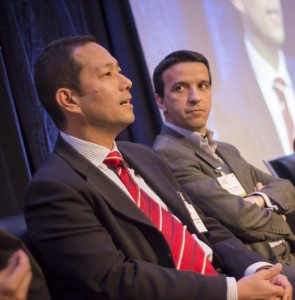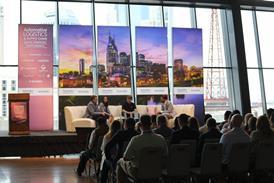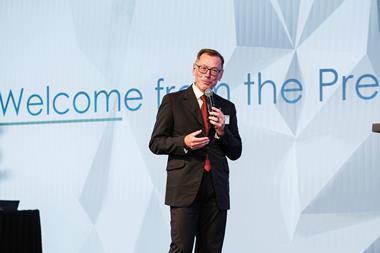The 2014 South America conference proved that inefficient logistics can not only disrupt production, but can hurt long-term growth. OEMs in Brazil are looking for ways to improve the supply chain and avoid falling further behind other countries.

During previous Automotive Logistics South America conferences, executives worried about Brazil’s logistics bottlenecks as a barrier to growth. ‘Logistics blackout’ was the oft-used phrase, referring to worst-case scenarios in which clogged ports would shut down import and export flows, traffic queues would disrupt assembly lines and products wouldn’t get where they needed to go.
This year, there were again familiar observations about Brazil’s infrastructure limits and inefficient processes: just 6% of its roads are paved; customs clearance is as costly as it is tedious; ships and trucks still face delays and backlogs at ports; there is almost no use of rail freight or short-sea shipping for automotive parts or vehicles.
- Competitive disadvantages
- Headaches at the border
- Multimodal visions
- Protagonistic logistics
- The Chinese are coming
Video recordings of the conference sessions are available with English translation here
For the past two years, however, Brazil has lacked the growth that would threaten its limited logistics capacity. After passenger vehicle sales more than doubled between 2002 and 2012, from 1.48m to 3.7m units, GDP has since flatlined; vehicle sales declined marginally in 2013 and more substantially this year, on pace for around 3.3m, according to Ricardo Pazzianotto, partner and automotive lead for Brazil at PwC Autofacts. Production has also been hit by a sharp economic deteriation in Argentina, Brazil’s principal export market for vehicles, where sales are down 30%. The smaller Venezuelan market has effectively been wiped out, with sales and production down 80%.
The lower volumes in South America have not solved the logistical issues, and concerns about logistics bottlenecks and delays, if not exactly blackouts, persist. However executives are now viewing Brazil’s supply chain inefficiencies as the major insult to its injuries, and a direct threat to the country’s competitiveness in the global economy, particularly as OEM investment in Latin America arguably shifts from Brazil to Mexico.
“Brazil is facing economic uncertainty, but it also needs to address high labour costs, logistics and tax issues in order to return to growth, otherwise it will struggle to compete with other countries,” said Pazzianotto.
While light vehicle assembly is forecasted to rise to around 5m units by 2020, PwC expects that by then Brazil will fall behind Mexico in production, which is growing as an export base both for US and other locations (including South America) even as Brazilian assembly becomes more focused on the domestic market.
"We expect Mexico to surpass Brazil by 2020. Mexico is more competitive on labour and other costs, while it also has established many bilateral free trade agreements that have opened up the market and encouraged global exports" - Ricardo Pazzianotto, PwC Autofacts
“We expect Mexico to surpass Brazil by 2020. Mexico is more competitive on labour and other costs, while it also has established many bilateral free trade agreements that have opened up the market and encouraged global exports,” said Pazzianotto (read more here on Brazil falling behind Mexico).
Mexico’s lower labour costs and trade links are advantages over Brazil – “they have a better neighbour in the US than we do with Argentina,” quipped Flavio Batista, vice-president of Latin America logistics at WWL – however, executives made it clear that Brazil’s logistics costs, inefficiencies and slow-moving bureaucracy have become a distinctive competitive disadvantage. Gustavo Bonini, head of inbound logistics for Scania, as well as coordinator for the logistics committee at Anfavea, the Brazilian carmaker’s association, said that the country’s export potential is severely hindered by its logistics costs and delays.
“The costs are very high, and it is purely waste,” he said. “Nobody is gaining from it. It is Brazil that is losing.”

The costs of doing business in Brazil – the custo Brasil, as it is commonly called – are notoriously high, particularly taxes, customs and a culture of regulation and bureaucracy. Neuton Karassawa, director of logistics for South America at GM, pointed out that such inefficiencies were competitive issues; slow imports and customs, for example, mean that manufacturers have to carry higher inventory levels. “International organisations like the World Bank see that Brazil’s competitiveness is going down, and that we to fill in more and more documents and deal with more bureaucracy,” he said. “Importing can take months and have a direct effect on our levels of inventory.”
Some parts of the Brazilian supply chain are also behind in IT systems and connectivity. According to Batista, many trucking companies in Brazil are small and poorly equipped. “Some have not even heard of EDI yet,” he said.
Nick Beard, corporate account industry director at TNT, which has significant operations in Brazil, pointed out that the pressures on the industry required better logistics than ever before: for example, most OEMs now offer extended warranties and fixed pricing for servicing. At the same time, other factors, such as shared car ownership models and increasing urbanisation, along with rising student debt and high youth unemployment, make meeting customer needs ever more critical for logistics.
“Logistics is getting squeezed by marketers promising the customers everything, and at the other end the LSPs are getting squeezed,” he said. “I would suggest we take another approach, and spend time working together, putting the issue on the table. We have shared issues that will only get worse, and if we don’t address them young people will walk away from buying cars.”
Importing nightmares
Brazil’s logistics issues hit carmakers and tier suppliers hard in a number of areas. One is the difficulty in ports when moving imported material into the country for production. While manufacturers have expanded local sourcing in Brazil, the country’s high costs often mean that importing material from other regions, particularly Asia and Europe, is often the lowest cost.
Fred Roldan, supply chain director for South America at General Motors, revealed that the carmaker imports around 140 containers per day into Brazil. He said that the process is difficult and costly, especially because of customs and crowded ports. “We use global sourcing extensively, and it can be a very effective strategy, but it has a high risk,” he said.

Fabio Castello, head of logistics for Scania Latin America, said that because trucks have lower volumes than passenger vehicles, it is more difficult to achieve the scale necessary to localise more parts. Of the company’s 900 suppliers, 700 of them are in Europe, which makes forecasting and planning production very challenging.
Such imports also leave manufacturers at the mercy of congested ports and lengthy customs clearance. Orlando Moral Junior, a former Volkswagen executive who is now manufacturing and logistics director in Brazil for China’s Chery, pointed out that delays and paperwork at ports were a major issue for his company, which is launching a new plant in January. In its initial phase, Chery will import 70% of its supplies from China.
“Because of the lengthy import process, our frozen period in production is around three-and-a-half months,” said Moral. “What causes this delay is the legal aspect for importing material, including taxes and bureaucracy. We have so many documents to deal with. It is something absurd in Brazil and it’s getting worse and worse.”
Is there hope for a multimodal Brazil?
Another area of obvious weakness for Brazil is the lack of rail services and multimodal logistics for the automotive industry. According to Gustavo Bonini, almost no vehicles move by rail in Brazil and fewer than 2% of components. Likewise, domestic short-sea shipping is not typically used in the country.

However, poor rail use for automotive is about more than a lack of tracks. Across all of the freight moved in Brazil, around 25% moves by rail and 14% by water, according to Bonini; however, agricultural and mineral products dominate the railways. Brazil doesn’t have the specialised equipment to make such services viable, such as bi-level and tri-level rail wagons for moving vehicles, or proper vehicle handling facilities at ports, said Batista. While the government has a role to play in these areas, Batista felt that part of the answer would come in private investment.
“It is a problem of investment. If you look at Brazil and Mexico, you are talking about very similar volumes, and so there is no reason why we couldn’t have rail and shipping,” he said. “It would take investment – perhaps $400m-500m in the case of rail – but someone has to be brave enough to do it.”
There is a similar gap in investment for ro-ro services and facilities. Following a reform of Brazil’s ports last year, which encouraged private spending and third party handling, Batista said that almost all companies were so far investing in container handling. “I have seen very little so far in the way of ro-ro and vehicle handling at the ports,” he said.
Lower cost shipping; barge and short sea from the Amazon
Batista highlighted a number of opportunities for multimodal services in Brazil that could save significant costs. He compared moving by road from the port of Alegre in the south to Salvador in the north, a distance of more than 3,000km. The benefit of road is speed and flexibility; vehicles can be dispatched at any time, and the transit time is about seven days. He gave sample freight costs of around R$20,000 ($7,900).

Batista admitted that such services would need increased visibility and better communication along the chain, but the benefits are obvious. “I don’t see how coastal shipping won’t happen for shipping vehicles and machines in Brazil,” he says.
There are already a few examples in the wider industry of multimodal services. BMS Logistics, a joint venture in Brazil between Germany’s BLG Logistics and Horst Mosolf, has since 2001 used barge transport to move motorcycles produced in Manaus, in Amazonas in the northwest, to the port of Belem in the northeast for onward distribution thousands of kilometres to the south. This is done mainly by road, according to Stephan Gruener, managing director at BMS. A few years ago, BMS moved 30-40% of the distribution to short-sea shipping in containers from Belem southbound on the coast.
“It’s a very difficult operation, and it has some drawbacks, but overall we have found it to be a useful alternative to road transport,” said Gruener.
Some of the benefits include a reduction in overall damages, thanks to the protective quality of containers. The pure transport costs are as much as 20% cheaper than the land-based route, however Gruener points out that the distribution has a longer lead time and requires more inventory. “Accounting for the increased inventory costs, the total costs are about 5% cheaper than land,” he said. “It also reduces CO2 emissions by around 20%.”
However, the shipping frequency for barge service can be infrequent and unreliable – motorcycles can wait up to seven days in Manaus for dispatch. Barges return to the plant empty. Likewise, container services from some of the northern ports, including São Luis and Pecém, have infrequent services, while the port of Santos in São Paulo is crowded and difficult to access.
“There is also a lot of bureaucracy to deal with for the container shipping service,” he admitted. “Bringing the cargo in by sea is almost treated as though it has been imported from another country.”

Brazil faces its share of problems, with the stagnant economy hurt further by high inflation. The re-election of Dilma Rousseff, whose Workers’ Party has been in power for 12 years, left some on the sidelines of the conference wondering where the impetus for change was going to come from. The infrastructure deficits have been a top issue for manufacturers for years, and most executives remain disappointed at the country’s progress. Investment for this past year’s World Cup and the next Summer Olympic Games have done something to expand capacity in airports, for example, but this was mainly for passengers. Indeed, Brazil saw an array of protests last year as citizens complained of poor public transport and services even as the country spent billions on stadiums.
And no doubt the stakes are high for making the industry more competitive, particularly as Brazil’s market is increasingly crowded. INOVAR, the country’s incentive programme for local production, has encouraged local assembly and slapped higher tariffs on imports, but may indirectly contribute to poor plant capacity utilisation, which is expected to hit a low of 65% this year. By 2023, PwC expects that there will be 23 carmakers building cars in Brazil, compared to half that amount during the 1990s. If manufacturers cannot compete for exports, their capacity will depend mostly on Brazil’s volatility.
What’s more, logistics costs are a direct barrier to export growth: Bonini pointed to Anfavea statistics that showed a 1% decrease in logistics cost can contribute to a 4% rise in exports.

“When we talk about infrastructure, it is easy to focus on things that are not in our reach,” he said. “It is important for us to spend a day like today with all of the problems that we face, to identify what we can do to make a difference and create actions for such. It’s true that we cannot leave aside the lobbying job that the civil entities must do for the government. But don’t let it become the focus of your daily routine. There are small things within your reach that you have to deal with to improve logistics.”
"We cannot leave aside the lobbying job that the civil entities must do for the government. But don’t let it become the focus of your daily routine. There are small things within your reach that you have to deal with to improve logistics" - Fabio Castello, Scania Latin America
While Brazil has stumbled the past two years, the economy is expected to pick up speed again. Although PwC’s Ricardo Pazzianotto expects Mexico to grow faster, Brazil is still expected to add 1.5m units of production by the end of this decade, with a host of carmakers investing in new production for Brazil, including Fiat Chrysler, Toyota, Hyundai, Nissan, Audi, BMW, Jaguar Land Rover and a number of Chinese producers, including Chery. Logistics will be essential to the productivity of OEMs and suppliers expanding here.

“Supermarkets will do the supply of small quantities, and we will use small packaging with specific routes,” he said. “We are also now developing the software side. Unfortunately, we did this at the end so it has to be adapted to our operations.”
In its initial phase, Chery will import 70% of its supplies from China – 25 containers per day in the start up phase. Moral admitted that the logistical problems in ports and with customs could be critical.
Moral admitted that it was an adjustment to move from Volkswagen, where production in Brazil ran to 3,200 car per day; Chery will commence with 150 per day, while importing a number of other vehicles from China. “You can’t just go and make the investments at the level of a VW, you have to take it easy and keep it simple,” he said.
Castello revealed that Scania had done more to work together internally as well as with logistics providers. The company recently brought together 34 logistics managers, from plant logistics to dispatchers, to discuss ways of improving operations across the chain.
GM’s Fred Roldan stressed the importance of risk management and supply chain monitoring. “We tend to be very good at dealing with problems as they occur, reacting to disruptions. What we are less good at is anticipating problems, such as financial difficulties at a supplier,” said Roldan.
GM’s Neuton Karassawa agreed that the supply chain is only as strong as its weakest link. “We know that this variation is very large, and that a small flu in the chain can turn into pneumonia at the end. We have to work as soon as possible to prevent issues.”
Roldan pointed to several measures important to GM, including using an evaluation process developed by AIAG and Odette that tries to highlight potential problems before they grow. It is a self-assessment tool, and it only works if suppliers are honest and open about their weaknesses. “Those suppliers who have red scores are not getting bad marks. It those which we should look to work with most openly and honestly, trying to make improvements,” Roldan said.
Roldan also said that GM was doing more to improve logistics “from the left”, referring to the early stages of vehicle development (which would move left to right in a business plan chart, starting from engineering through to series production). “We’ve started working more with engineers and purchasing right at the development stage to react and influence decisions,” he said. “We didn’t do that three or four years ago. At first, the engineers were asking, 'why are we working with you [logistics] already?'. But we can have a real impact on the supplier footprint and the production decisions.”
Elsewhere, companies are looking to make better use of technology and IT systems to improve their logistics. Stefan Gruener revealed that BMS had invested in a new transport management system that helps to process and pay invoices, control stock and track cargo with EDI messages along its multimodal routes. The company has seen improvements in performance and costs since launching the system.
Such examples where executives were taking action as the ‘protaganist’ were encouraging, even if companies remain the victims of the economy and higher costs. Gustavo Bonini said that the Anfavea logistics committee was now meeting every fortnight and that it had started to make headway with a number of government departments, including the transport and economic development ministries. There were a number of examples of real improvements, including pre-scheduling of truckloads at ports, as well further discussion on extending opening hours at ports.
“We invite authorities, government entities and logistics operators to our meetings, so that we can find a solution for the short, medium and long term,” he said. “It is no good just planning new roads, we need other solutions. If we just think about short-term solutions, we will eventually come to a halt.”
The Automotive Logistics series of conferences includes event in North America, Latin America, Europe, India and China. The event on the calendar will be Automotive Logistics India, 9-11 December in New Delhi.
The next event in Latin America will be Automotive Logistics Mexico, 27-29th 2015 in Mexico City.





































